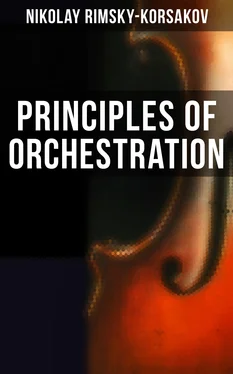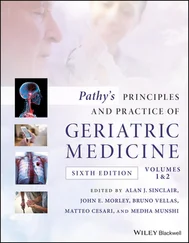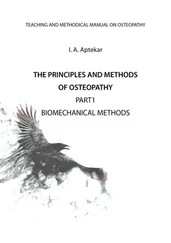The gigantic figure of Beethoven stands apart. His music abounds in countless leonine leaps of orchestral imagination, but his technique, viewed in detail, remains much inferior to his titanic conception. His use of the trumpets, standing out above the rest of the orchestra, the difficult and unhappy intervals he gives to the horns, the distinctive features of the string parts and his often highly-coloured employment of the wood-wind,—these features will combine causing the student of Beethoven to stumble upon a thousand and one points in contradiction.
It is a mistake to think that the beginner will light upon no simple and instructive examples in modern music, in that of Wagner and others. On the contrary, clearer, and better examples are to be found amongst modern composers than in what is called the range of classical music.
Extract from the Preface to the last edition.
Table of Contents Table of Contents VOLUME I VOLUME I Table of Contents Chapter I. GENERAL REVIEW OF ORCHESTRAL GROUPS. Chapter I. GENERAL REVIEW OF ORCHESTRAL GROUPS. Table of Contents Chapter II. MELODY. Chapter III. HARMONY. Chapter IV. COMPOSITION OF THE ORCHESTRA. Chapter V. COMBINATION OF THE HUMAN VOICE WITH ORCHESTRA. THE STAGE BAND. Chapter VI (Supplementary). VOLUME II
My aim in undertaking this work is to reveal the principles of modern orchestration in a somewhat different light than that usually brought to bear upon the subject. I have followed these principles in orchestrating my own works, and, wishing to impart some of my ideas to young composers, I have quoted examples from my own compositions, or given references to them, endeavouring to show, in all sincerity, what is successful and what is not. No one can know except the author himself the purpose and motives which governed him during the composition of a certain work, and the practice of explaining the intentions of a composer, so prevalent amongst annotators, however reverent and discreet, appears to me far from satisfactory. They will attribute a too closely philosophic, or excessively poetic meaning to a plain and simple fact. Sometimes the respect which great composers' names command will cause inferior examples to be quoted as good; cases of carelessness or ignorance, easily explained by the imperfections of current technique, give rise to whole pages of laborious exposition, in defence, or even in admiration of a faulty passage.
This book is written for those who have already studied instrumentation from Gevaert's excellent treatise, or any other well-known manual, and who have some knowledge of a number of orchestral scores.
I shall therefore only just touch on such technical questions as fingering, range, emission of sound etc.[6]
The present work deals with the combination of instruments in separate groups and in the entire orchestral scheme; the different means of producing strength of tone and unity of structure; the sub-division of parts; variety of colour and expression in scoring,—the whole, principally from the standpoint of dramatic music.
Table of Contents Table of Contents VOLUME I VOLUME I Table of Contents Chapter I. GENERAL REVIEW OF ORCHESTRAL GROUPS. Chapter I. GENERAL REVIEW OF ORCHESTRAL GROUPS. Table of Contents Chapter II. MELODY. Chapter III. HARMONY. Chapter IV. COMPOSITION OF THE ORCHESTRA. Chapter V. COMBINATION OF THE HUMAN VOICE WITH ORCHESTRA. THE STAGE BAND. Chapter VI (Supplementary). VOLUME II
Chapter I. GENERAL REVIEW OF ORCHESTRAL GROUPS.
Table of Contents Table of Contents VOLUME I VOLUME I Table of Contents Chapter I. GENERAL REVIEW OF ORCHESTRAL GROUPS. Chapter I. GENERAL REVIEW OF ORCHESTRAL GROUPS. Table of Contents Chapter II. MELODY. Chapter III. HARMONY. Chapter IV. COMPOSITION OF THE ORCHESTRA. Chapter V. COMBINATION OF THE HUMAN VOICE WITH ORCHESTRA. THE STAGE BAND. Chapter VI (Supplementary). VOLUME II
The following is the formation of the string quartet and the number of players required in present day orchestras, either in the theatre or concert-room.
|
Full orchestra |
Medium orchestra |
Small orchestra |
| Violins I |
16 |
12 |
8 |
| " II |
14 |
10 |
6 |
| Violas |
12 |
8 |
4 |
| Violoncellos |
10 |
6 |
3 |
| Double basses |
8-10 |
4-6 |
2-3 |
In larger orchestras, the number of first violins may amount to 20 and even 24, the other strings being increased proportionately. But such a great quantity of strings overpowers the customary wood-wind section, and entails re-inforcing the latter. Sometimes orchestras contain less than 8 first violins; this is a mistake, as the balance between strings and wind is completely destroyed. In writing for the orchestra it is advisable to rely on a medium-sized body of strings. Played by a larger orchestra a work will be heard to greater advantage; played by a smaller one, the harm done will be minimised.
Whenever a group of strings is written for more than five parts—without taking double notes or chords into consideration—these parts may be increased by dividing each one into two, three and four sections, or even more ( divisi ). Generally, one or more of the principal parts is split up, the first or second violins, violas or violoncellos. The players are then divided by desks, numbers 1, 3, 5 etc. playing the upper part, and 2, 4, 6 etc., the lower; or else the musician on the right-hand of each desk plays the top line, the one on the left the bottom line. Dividing by threes is less easy, as the number of players in one group is not always divisible by three, and hence the difficulty of obtaining proper balance. Nevertheless there are cases where the composer should not hesitate to employ this method of dividing the strings, leaving it to the conductor to ensure equality of tone. It is always as well to mark how the passage is to be divided in the score; Vns I, 1, 2, 3 desks, 6 'Cellos div. à 3, and so on. Division into four and more parts is rare, but may be used in piano passages, as it greatly reduces volume of tone in the group of strings.
Note. In small orchestras passages sub-divided into many parts are very hard to realise, and the effect obtained is never the one required.
String parts may be divided thus:
| a |
{ |
Vns I div. Vns II div. |
b |
{ |
Vns II div. Violas div. |
c |
{ |
Violas div. 'Cellos div. |
d |
{ |
'Cellos div. D. basses div. |
Possible combinations less frequently used are:
| e |
{ |
Vns I div. Violas div. |
f |
{ |
Vns II div. 'Cellos div. |
g |
{ |
Violas div. D. basses div. etc. |
Note. It is evident that the tone quality in b and e will be similar. Still b is preferable since the number of Vns II (14-10-6) and Violas (12-8-4) is practically the same, the respective rôles of the two groups are more closely allied, and from the fact that second violins generally sit nearer to the violas than the first, thereby guaranteeing greater unity in power and execution.
The reader will find all manner of divisions in the musical examples given in Vol. II
. Where necessary, some explanation as to the method of dividing strings will follow in due course. I dwell on the subject here in order to show how the usual composition of the string quartet may be altered.
Stringed instruments possess more ways of producing sound than any other orchestral group. They can pass, better than other instruments from one shade of expression to another, the varieties being of an infinite number. Species of bowing such as legato , detached, staccato , spiccato , portamento , martellato , light staccato , saltando , attack at the nut and at the point,  and
and  (down bow and up bow), in every degree of tone, fortissimo , pianissimo , crescendo , diminuendo , sforzando , morendo —all this belongs to the natural realm of the string quartet.
(down bow and up bow), in every degree of tone, fortissimo , pianissimo , crescendo , diminuendo , sforzando , morendo —all this belongs to the natural realm of the string quartet.
Читать дальше

 and
and  (down bow and up bow), in every degree of tone, fortissimo , pianissimo , crescendo , diminuendo , sforzando , morendo —all this belongs to the natural realm of the string quartet.
(down bow and up bow), in every degree of tone, fortissimo , pianissimo , crescendo , diminuendo , sforzando , morendo —all this belongs to the natural realm of the string quartet.










